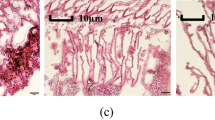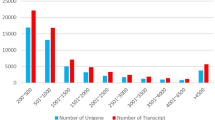Abstract
Procambarus clarkii is an important model crustacean organism in many researches. Ammonia nitrogen is one of common contaminants in aquatic environment, influencing the health of aquatic organisms. The primary objective of this study was to investigate molecular mechanisms on ammonia stress in gills of P. clarkii to provide new insights into the strategies of aquatic animals in responding to high concentration of ammonia in the environment. Procambarus clarkii were randomly assigned into two groups (ammonia stress group, AG; control group, CG), and gill samples were dependently excised from AG and CG. Then response mechanisms on ammonia stress were investigated based on transcriptome data of P. clarkii. 9237 differentially expressed genes were identified in ammonia stress group. The genes of ion transport enzymes (NKA and SLC6A5S) were significantly up-regulated. Whereas the immune-related genes (e.g. MAP3K7, HSP70, HSP90A, CTSF, CTSL1, CHI and CTL4) and pathways were significantly up-regulated, which played an important role in reacting to ammonia stress. Procambarus clarkii may enhance immune defense to counteract ammonia toxicity by the up-regulation of immune-related genes and signaling pathways. The activities of ion transport enzymes are changed to mobilise signal transduction and ion channel regulation for adapting to ammonia environment. These previous key genes play an important role in resistance to ammonia stress to better prepare for survival in high concentration of ammonia.



Similar content being viewed by others
References
Ip Y (2010) Ammonia production, excretion, toxicity and defense in fish: a review. Front Physiol 1:134
Randall DJ, Tsui TKN (2002) Ammonia toxicity in fish. Mar Pollut Bull 45:17–23
Pan CH, Chien Y, Hunter B (2003) The resistance to ammonia stress of Penaeus monodon fabricius juvenile fed diets supplemented with astaxanthin. J Exp Mar Biol Ecol 297:107–118
Sinha AK, Liew HJ, Diricx M, Blust R, Boeck GD (2012) The interactive effects of ammonia exposure, nutritional status and exercise on metabolic and physiological responses in gold fish (Carassius auratus L.). Aquat Toxicol 109:33–46
Cheng CH, Yang FF, Ling RZ, Liao SA, Miao YT, Ye CX, Wang AL (2015) Effects of ammonia exposure on apoptosis, oxidative stress and immune response in pufferfish (Takifugu obscurus). Aquat Toxicol 164:61–71
Yue F, Pan L, Xie P, Zheng DB (2010) Immune responses and expression of immune-related genes in swimming crab Portunus trituberculatus exposed to elevated ambient ammonia-N stress. Comp Biochem Phys A 157:246–251
Cui Y, Ren X, Li J, Zhai QQ, Feng YY, Xu Y, Ma L (2017) Effects of ammonia-N stress on metabolic and immune function via the neuroendocrine system in Litopenaeus vannamei. Fish Shellfish Immun 64:270–275
Rodrigues RV, Schwarz MH, Delbos BC, Carvalho EL, Romano LA, Sampaio LA (2011) Acute exposure of juvenile cobia Rachycentron canadum to nitrate induces gill, esophageal and brain damage. Aquaculture 226:322–323
Sinha AK, Matey V, Giblen T, Blust R, Boeck GD (2014) Gill remodeling in three freshwater teleosts in response to high environmental ammonia. Aquat Toxicol 155:166–180
Chen JC, Chen CT, Cheng SY (1994) Nitrogen excretion and changes of hemocyanin, protein and free amino acid levels in the hemolymph of Penaeus monodon exposed to different concentrations of ambient ammonia-N at different salinity levels. Mar Ecol Prog Ser 110:85–94
Lv X, Kong J, Luan S, Bai P (2016) Transcriptome analysis of the hepatopancreas in the Pacific white shrimp (Litopenaeus vannamei) under acute ammonia stress. PLoS ONE 11:164396
Hong ML, Chen LQ, Sun XJ, Gu SZ, Zhang L, Chen Y (2007) Metabolic and immune responses in Chinese mitten-handed crab (Eriocheir sinensis) juveniles exposed to elevated ammonia. Comp Biochem Physiolo C 145:363–369
Ren Q, Pan L, Zhao Q, Si LJ (2015) Ammonia and urea excretion in the swimming crab Portunus trituberculatus exposed to elevated ambient ammonia-N. Comp Biochem Physiol A 187:48–54
Wang W, Gu W, Ding ZF, Ren YL, Chen JX, Hou YY (2005) A novel Spiroplasma pathogen causing systemic infection in the crayfish Procambarus clarkii (Crustacea: Decapod), in China. Fems Microbiol Lett 1:1
Zhao W, Wang L, Liu M, Jiang KY, Wang MQ, Yang G, Qi CC, Wang BJ (2017) Transcriptome, antioxidant enzyme activity and histopathology analysis of hepatopancreas from the white shrimp Litopenaeus vannamei fed with aflatoxin B1(AFB1). Dev Comp Immunol 74:69–81
Zhang ZY, Zhang MQ, Wu Y, Wu GH (2014) Biological accumulation and release of Cd and Cu in Procambarus clarkia. Food Sci 35:250–254
Dong XX, Li Z, Wang XH, Zhou M, Lin L, Zhou Y, Li JQ (2016) Characteristics of Vibrio parahaemolyticus isolates obtained from crayfish (Procambarus clarkii) in freshwater. Int J Food Microbiol 238:132–138
Tang D, Shi XL, Guo HY, Bai YZ, Shen CC, Zhang YP, Wang ZF (2020) Comparative transcriptome analysis of the gills of Procambarus clarkii provides novel insights into the immune-related mechanism of copper stress tolerance. Fish Shellfish Immunol 96:32–40
El-Assal FM, Sabet SF, Varjabedian KG, Fol MF (2014) Pollution of freshwater coelatura species (mollusca: bivalvia: unionidae) with heavy metals and its impact on the ecosystem of the river nile in Egypt. Int J Waste Res 4:1–11
Ip YK, Chew SF, Randall DJ (2001) Ammonia toxicity, tolerance and excretion. Fish Physiol 20:109–148
Burnett LE, McMahon BR (1985) Facilitation of CO2 excretion by carbonic anhydrase located on the surface of the basal membrane of crab gill epithelium. Resp Physiol 62:348
Henry RP, Lucu C, Onken H, Weihrauch D (2012) Multiple functions of the crustacean gill: osmotic/ionic regulation, acid-base balance, ammonia excretion and bioaccumulation of toxic metals. Front Physiol 3:431
Huang Y, Wang M, Zhao XM, Shi Q (2018) Transcriptome sequencing of the gill and barbel of Southern catfish (Silurus meridionalis) revealed immune responses and novel rhamnose-binding lectins (RBLs). Genomics 111:222–230
Racotta IS, Hernández-Herrera R (2000) Metabolic responses of the white shrimp, Penaeus vannamei, to ambient ammonia. Comp Biochem Physiol A 125:437–443
Xu Z, Takizawa F, Parra D, Gómez D, Jørgensen LVG, LaPatra SE, Sunyer JO (2016) Mucosal immunoglobulins at respiratory surfaces mark an ancient association that predates the emergence of tetrapods. Nat Commun 7:10728
Wang W, Yang SP, Wang CG, Shi LL, Guo H, Chan SM (2017) Gill transcriptomes reveal involvement of cytoskeleton remodeling and immune defense in ammonia stress response in the banana shrimp Fenneropenaeus merguiensis. Fish Shellfish Immunol 71:319
Weihrauch D, Wilkie MP, Walsh PJ (2009) Ammonia and urea transporters in gills of fish and aquatic crustaceans. J Exp Biol 212:1716–1730
Mortazavi A, Williams BA, McCue K, Schaeffer L, Wold B (2008) Mapping and quantifying mammalian transcriptomes by RNA-Seq. Nat Methods 5:621
Kanehisa M, Araki M, Goto S, Hattori M, Hirakawa M, Itoh M, Katayama T, Kawashima S, Okuda S (2007) KEGG for linking genomes to life and the environment. Nucleic Acids Res 36:480–484
Jiang HC, Qian ZJ, Lu W, Ding HY, Yu HW, Wang H, Li JL (2015) Identification and characterization of reference genes for normalizing expression data from red swamp crawfish Procambarus clarkii. Int J Mol Sci 16(9):21591–21605
Livak K, Schmittgen T (2000) Analysis of relative gene expression data using real-time quantitative PCR and the 2−△△Ct method. Methods 25:402–408
Chen JC, Cheng SY, Chen CT (1994) Changes of haemocyanin, protein and free amino acid levels in the haemolymph of Penaeus japonicus exposed to ambient ammonia. Comp Biochem Physiol A 109:339–347
Yang Y, Cheng J, Singhal SS, Saini M, Pandya U, Awasthi S, Awasthi YC (2001) Role of glutathione S-transferases in protection against lipid peroxidation overexpression of HGSTA2-2 in K562 cells protects against hydrogen peroxide-induced apoptosis and inhibits JNK and caspase 3 activation. J Biol Chem 276:19220–19230
Liu C, Chen J (2004) Effect of ammonia on the immune response of white shrimp Litopenaeus vannamei and its susceptibility to Vibrio alginolyticus. Fish Shellfish Immun 16:321–334
Ellis AE (2001) Innate host defense mechanisms of fish against viruses and bacteria. Dev Comp Immunol 25:827–839
Meng X, Hong L, Yang TT, Liu Y, Jiao T, Chu XH, Zhang DZ, Wang ZL, Tang BP, Liu HT, Wang J, Mao Y, Niu SF, Qiao Y, Su YQ, Wang CZ, Zheng ZP (2016) Identification and expression analysis of a new invertebrate lysozyme in Kuruma shrimp (Marsupenaeus japonicus). Fish Shellfish immun 49:336–343
Zhou M, Abbas MN, Kausar S, Jiang CX (2017) Transcriptome profiling of red swamp crayfish (Procambarus clarkii) hepatopancreas in response to lipopolysaccharide (LPS) infection. Fish Shellfish Immunol 71:423–433
Liang C, Liu J, Cao F, Li Z, Chen T (2019) Transcriptomic analyses of the acute ammonia stress response in the hepatopancreas of the kuruma shrimp (Marsupenaeus japonicas). Aquaculture 513:734328
Cheng CH, Ma HL, Su YL, Deng YQ, Feng J, Xie JW, Chen XL, Guo ZX (2019) Ammonia toxicity in the mud crab (Scylla paramamosain): the mechanistic insight from physiology to transcriptome analysis. Ecotoxicol Environ Saf 179:9–16
Ren X, Wang X, Liu P, Li J (2019) Bioaccumulation and physiological responses in juvenile Marsupenaeus japonicus exposed to cadmium. Aquat Toxicol 214:105255
Turk D (2001) Structure of human dipeptidyl peptidase I (cathepsin C): exclusion domain added to an endopeptidase framework creates the machine for activation of granular serine proteases. Embo J 20:6570–6582
Nakagawa T (1998) Cathepsin L: critical role in Ii degradation and CD4 T cell selection in the thymus. Science 280:450–453
Liu QN, Zhang WW, He WF (2019) Transcriptome-wide identification of differentially expressed genes in Procambarus clarkii in response to chromium challenge. Fish Shellfish immunol 87:43–50
Wang PH, Yang LS, Gu ZH, Weng SP, Yu XQ, He JG (2013) Nucleic acid-induced antiviral immunity in shrimp. Antivir Res 99:270–280
Adachi Y, Ishii T, Ikeda Y, Hoshino A, Tamura H, Aketagawa J, Tanaka S, Ohno N (2004) Characterization of beta-glucan recognition site on C-type lectin, dectin 1. Infect Immun 72:4159
Li YD, Zhou FL, Huang JH, Yang SH, Jiang S, Yang QB, He JG, Jiang SG (2018) Transcriptome reveals involvement of immune defense, oxidative imbalance, and apoptosis in ammonia-stress response of the black tiger shrimp (Penaeus monodon). Fish Shellfish Immun 83:162–170
Castilho PC, Martins IA (2001) Bianchini A. Gill Na+, K+-ATPase and osmoregulation in the estuarine crab, Chasmagnathus granulata Dana, 1851 (Decapoda, Grapsidae). J Exp Mar Biol Ecol 256:215–227
Chen N, Reith ME, Quick MW (2004) Synaptic uptake and beyond: the sodium-and chloride-dependent neurotransmitter transporter family SLC6. Pflug Arch Eur J Phy 447:519–531
Yang ZG, Zhou JY, Wei BH, Cheng WX, Zhang L, Zhen XM (2019) Comparative transcriptome analysis reveals osmotic-regulated genes in the gill of Chinese mitten crab (Eriocheir sinensis). PLoS ONE 14:1
Funding
This study was supported by grants from National Natural Science Foundation of China to ZFW (Grant No. 31702014), Jiangsu Provincial Key Laboratory for Bioresources of Saline Soils Open Foundation to ZFW (Grant No. JKLBS2019006), and Doctoral Scientific Research Foundation of Yancheng Teachers University to ZFW.
Author information
Authors and Affiliations
Contributions
All authors contributed to the study conception and design. Investigation: ZFW, CCS and YQL; Data curation, CCS, DT and YQL, Funding acquisition, ZFW, Project administration, CCS and YQL, Resources, ZFW and DT; Software, CCS and YQL, Validation, WL and YPZ; Visualization, CCS and YQL, Writing—original draft, CCS, Writing—review and editing, CCS, DT and YZB. All authors have read and agreed to the published version of the manuscript.
Corresponding author
Ethics declarations
Conflicts of interest
The authors declare that they have no conflicts of interest.
Ethical approval
All applicable international, national, and/or institutional guidelines for the care and use of animals were followed.
Additional information
Publisher's Note
Springer Nature remains neutral with regard to jurisdictional claims in published maps and institutional affiliations.
Supplementary Information
Below is the link to the electronic supplementary material.
Rights and permissions
About this article
Cite this article
Shen, C., Tang, D., Bai, Y. et al. Comparative transcriptome analysis of the gills of Procambarus clarkii provide novel insights into the response mechanism of ammonia stress tolerance. Mol Biol Rep 48, 2611–2618 (2021). https://doi.org/10.1007/s11033-021-06315-y
Received:
Accepted:
Published:
Issue Date:
DOI: https://doi.org/10.1007/s11033-021-06315-y




